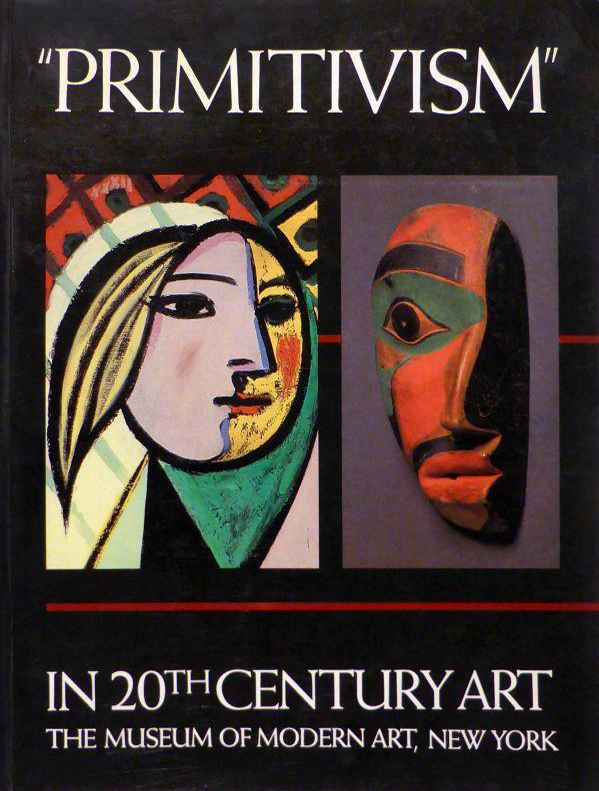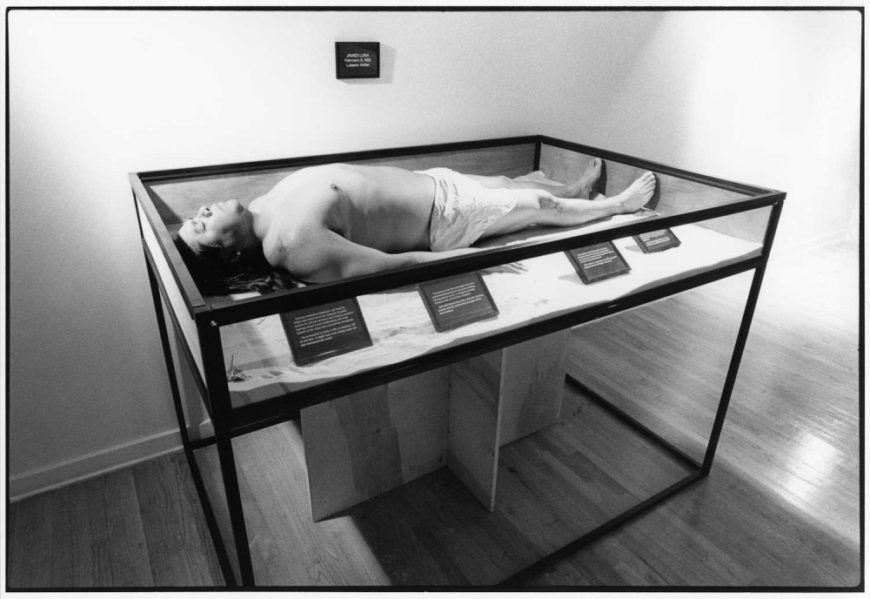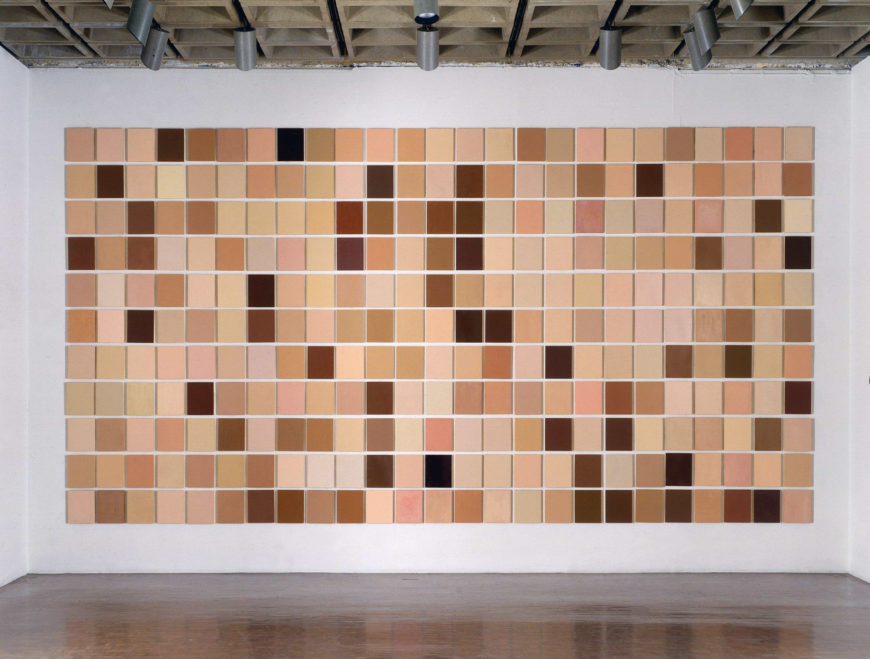
Cover of volume 1 of the catalog to the exhibition, “‘Primitivism’ in 20th Century Art: Affinities of the Tribal and the Modern,” 1984 (The Museum of Modern Art, New York)
Whose art history?
For most of the twentieth century, major American museums rarely exhibited the work of artists from underrepresented groups, preferring instead to privilege the dominant narratives of a white, male, heterosexual art history. The 1984 blockbuster exhibition “‘Primitivism’ in 20th Century Art: Affinities of the Tribal and the Modern” at The Museum of Modern Art in New York, for example, juxtaposed the work of recognized masters of modern art with artifacts from nonwestern (mostly African or East Asian) populations. However, the relative positioning of the nonwestern works seemed to many observers to present these objects as inferior to the works of European and American artists.
Critics of the exhibition specifically took issue with MoMA’s emphasis on formal comparisons of western objects by well-known modern and contemporary artists (e.g., Constantin Brancusi, Paul Gauguin, and Pablo Picasso) and nonwestern objects produced by unidentified artists and artisans. The exhibition failed to consider the significant political, ideological, and social contexts of its nonwestern objects—a presentation that some critics argued positioned the works of European and American artists as more “advanced.” For many artists, critics, and curators positioned outside the so-called mainstream art world it was becoming increasingly clear that nonwhite artists were only included in major museum exhibitions if they reinforced these hierarchies.
Addressing a history of exclusion: “The Decade Show”
In response to this history of exclusion, and to MoMA’s “Primitivism” show specifically, three cultural institutions in New York City collaborated on an exhibition that would recognize the perspectives of marginal groups and assign them a place in a mainstream. The landmark exhibition “The Decade Show: Frameworks of Identity in the 1980s,” organized by curators from The New Museum of Contemporary Art, The Studio Museum in Harlem, and The Museum of Contemporary Hispanic Art, opened in May 1990 and featured more than 200 objects by ninety-four artists of diverse heritage. According to the organizers, “The Decade Show” artists were connected by their willingness to address the phenomenon of exclusion in their work. This exhibition worked from the idea that as the perspectives of the marginalized entered the mainstream, they would likewise receive greater political agency.

James Luna, Artifact Piece, 1987, photograph of performance 121.9 x 152.4 cm, courtesy of the artist © James Luna, photograph by Robin Holland (New Museum)
James Luna, a Pooyukitchum and Mexican-American artist included in “The Decade Show,” was one of many artists working in this period to reconstruct a political position via representational visibility. For his performance Artifact Piece, the artist lay inside a display case at the Studio Museum in Harlem with his nude body covered only by a breechcloth. Small white cards with stories describing the origin of several body markings (scars, tan lines, etc.) and written in the third person were scattered alongside the artist’s body. The perceived objectivity of the descriptive cards and Luna’s own prone position in the display case, allows Artifact Piece to directly reference the history of ethnographic displays, which often positioned “other” bodies as objects to be looked at by a mainstream public.
As Luna explained in a 2008 interview: “I had long looked at representation of our peoples in museums and they all dwelled in the past. They were one-sided. We were simply objects among bones, bones among objects, and then signed and sealed with a date.” Luna’s inclusion of his own subjective narrative radically transforms the historically marginalized body of the “other” in the museum from a passive object to a speaking agent. Artifact Piece also played an important part in inverting the power dynamics between the observed and the observer. Here, Luna placed himself on display; his presence in an art museum creates an unsettling effect for the viewer, who is forced to consider their own relationship to this history of display and exploitation.
1993 Whitney Biennial
On the heels of “The Decade Show,” several other institutions began to reconsider their relationship to artists outside the mainstream. Perhaps the most well known of these exhibitions was the 1993 Biennial exhibition at the Whitney Museum of American Art, which many scholars consider to be the turning point for identity-based art discourse. The main theme of this exhibition, according to David Ross, the Whitney’s director at the time, was “the construction of identity.” Contemporary artists, Ross claimed, “insist on reinscribing the personal, political, and social back into the practice and history of art.” Reviews of the exhibition show that the effects of this reinscription were received ambivalently; many critics praised the shows risk-taking, while others questioned the aesthetic merits of the works. Nevertheless, it was impossible to ignore the emergence of an entire generation of artists, including Renée Green, Byron Kim, Glenn Ligon, Pepón Osorio, and Lorna Simpson, who were explicitly working to de-center the institutional focus on whiteness.

Byron Kim, Synecdoche, 1991–present, oil and wax on 275 panels, each 25.4 x 20.32 cm, courtesy the artist and Max Protetch Gallery, New York © 2008 Byron Kim (The Museum of Modern Art, New York)
Byron Kim’s contribution to the exhibition, a multi-paneled painting titled Synecdoche, 1991-present, captures both the aesthetic and political ambitions of art in this period. On first glance, Kim’s monochromatic palette and his arrangement of small paintings into a grid seem to recall minimalist work of the 1960s. However, visitors to the exhibition quickly learned that Synecdoche was much more than an aesthetic exercise. To construct the work, Kim asked members of his community (friends, neighbors, strangers) to let him copy the color of their skin, which the artist then reproduced in oil on a ten-by-eight-inch canvas panel.
Far from an exercise in objectivity or geometry, each small painting is a portrait. The title of Kim’s work refers to a figure of speech, in which a term for a part of something refers to the whole of something, or vice-versa (e.g., saying “all hands on deck” to refer to a group of sailors). In Synecdoche, each individual person pictured is reduced to and represented by skin color alone. But in highlighting the uniqueness and individuality of every skin tone, this painting provokes us to reconsider the ways in which skin color has been used to stereotype or otherwise marginalize individuals. In this way, Synecdoche set a standard for dealing with the complexity of the visual markers of identity.
Shifting art history
As the ideas and perspectives from non-white artists, queer artists, and those with other intersectional identities were given space in the museum throughout the 1990s, the terrain of art history began to shift as well. We are still seeing the effects of this today as more and more artists from the margins enter mainstream institutions and their histories. In the words of author and activist bell hooks, difference means not only exclusion but “the site of radical possibility, a space of resistance.”

